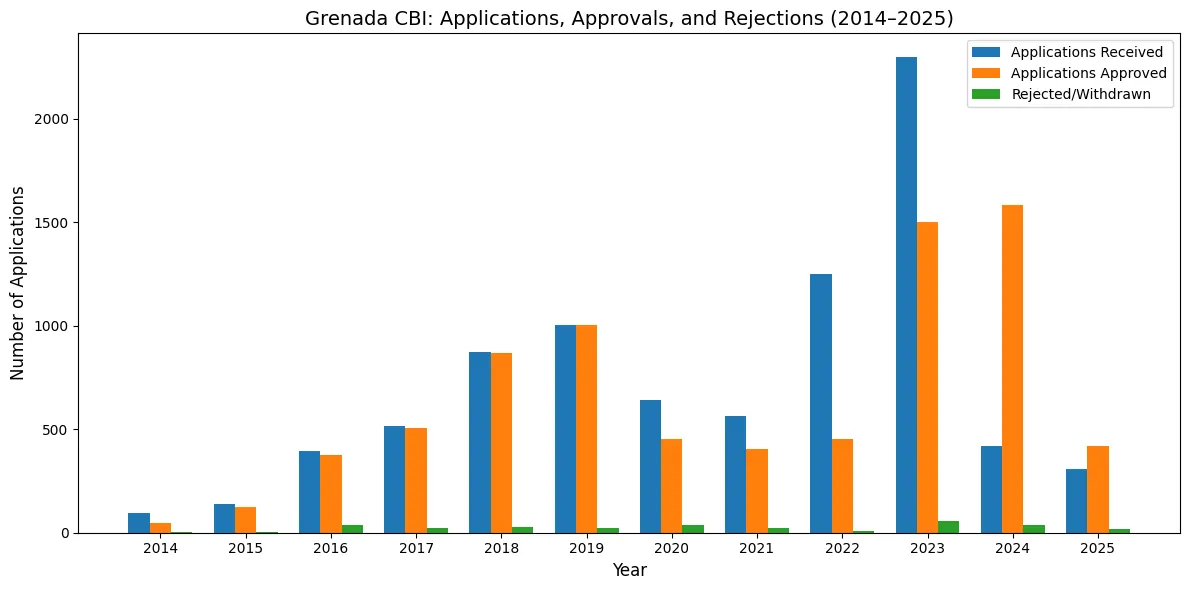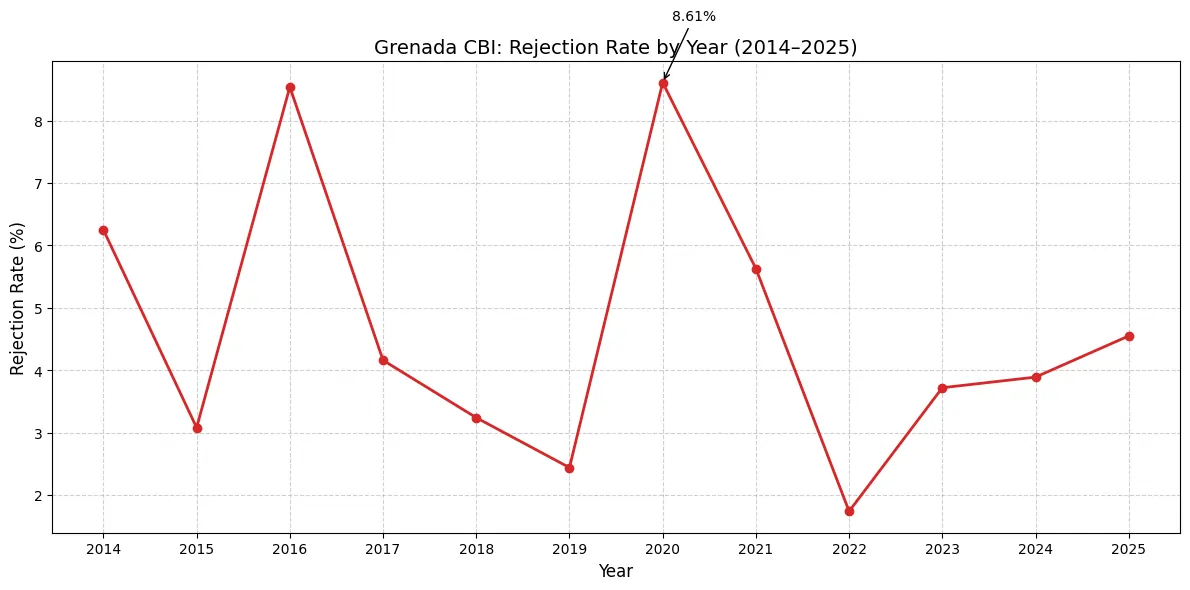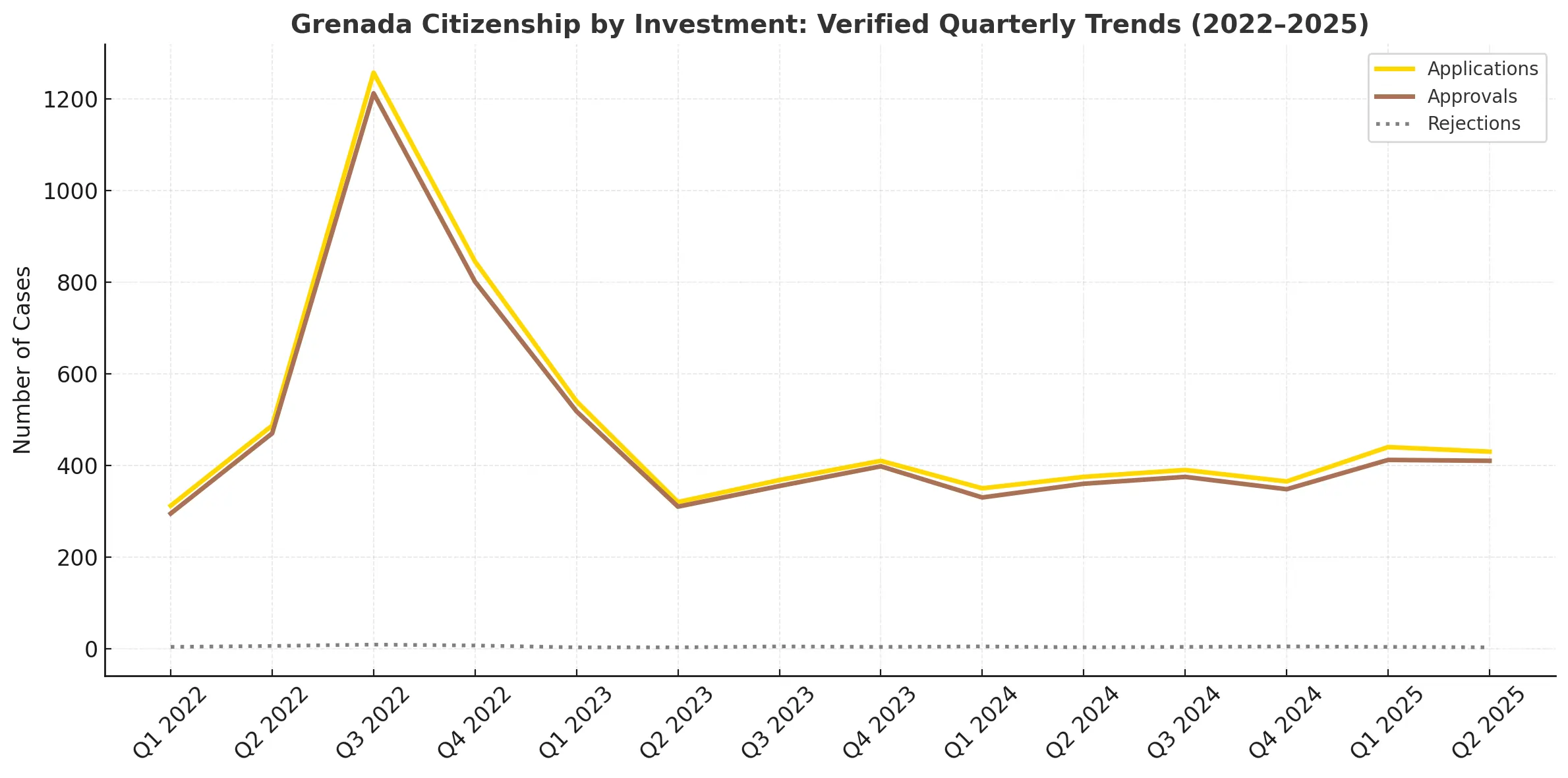Grenada's Citizenship by Investment (CBI) programme is more than just an alternative passport route. It plays a central role in the country's economy, accounting for over one-third of the capital budget recently. This makes CBI not only a tool for attracting international investors but also a strategic pillar of national development.
This page presents the most comprehensive and up-to-date statistical analysis of Grenada’s CBI programme, covering every quarter and year from its launch in 2014 through to the latest figures in 2025. All data is drawn directly from official sources, including the Investment Migration Agency (IMA), Ministry of Finance, IMF, and World Bank. 1, 2, 3;
Unlike most over-optimised summaries, this guide offers a transparent and evidence-based look at applications, revenues, approval trends, and global shifts that have shaped Grenada’s approach to economic citizenship.
Key Highlights: Grenada CBI at a Glance
Since its official launch in 2014, Grenada’s citizenship-by-investment program has grown into a cornerstone of the country’s economic strategy.
These key figures capture the scale, impact, and evolving nature of the programme:
The following in-depth breakdown is based on these headline statistics.
From Launch to Lifeline: A Brief History of Grenada's CBI Program
Grenada's Citizenship by Investment program was introduced in 2013 and became operational in 2014, with the aim of attracting foreign capital in exchange for economic citizenship.
What began as a modest, low-profile initiative quickly evolved into a critical pillar of national fiscal strategy.
Over the course of a decade, the program has transformed from an experimental revenue stream to one of the most significant sources of development funding in the country.
The CBI timeline below outlines the major milestones and structural shifts that shaped this transformation:
This decade-long evolution illustrates not just rising application numbers but a deepening integration of CBI revenue into Grenada’s national development priorities.
In the next section, we turn to the concrete numbers that underpin this story, year by year and quarter by quarter.
Applications and Approvals: Year-by-Year Breakdown (2014–2025)
Since 2014, Grenada’s citizenship-by-investment program has evolved from a cautious pilot into a high-volume engine of fiscal support. The number of applications surged nearly sixfold between 2016 and 2023, reflecting the program’s growing international profile and its appeal to families, particularly in China, Russia (pre-ban), and the Middle East.
However, the volume alone does not provide a complete picture. Below we break down the programme’s performance by year, tracking applications received, approvals granted, rejections, rejection rate, and estimated total new citizenships issued.

The chart above shows just how dramatic the growth has been. With only 393 applications in 2016, Grenada hit a peak of 2,297 applications in 2023, its highest on record. But the surge wasn’t a straight upward climb.
The COVID-19 pandemic in 2020 caused a sharp contraction of -36%, leading to a halt in international mobility. The program recovered strongly in 2021 and 2022, buoyed by investor demand in sanctioned markets and new agent networks.

The line graph above reveals the rejection story — a less-discussed but equally telling trend. In 2020, Grenada recorded its highest rejection rate (8.61%), a signal of tightening due diligence as scrutiny increased globally. A similar uptick occurred in 2024, climbing to 3.89% as the IMA implemented stronger vetting post-Russia ban.
In contrast, 2022 had the lowest rejection rate on record (1.74%), reflecting strong demand from vetted markets and improved application quality.
As you can see in the table above, 2024 was a transition year. While new application volume declined following geopolitical bans and investment rule tightening, the number of approvals soared — not because of a spike in demand, but because the newly launched Investment Migration Agency cleared a backlog of thousands of pending files.
These stat cards offer a quick glance at some of the standout moments from the last decade. They’re more than trivia; they reflect inflection points in policy, perception, and global mobility economics.
Quarterly Trends and Market Volatility (Q1 2017–Q2 2025)
While annual numbers show the long-term trajectory of Grenada’s CBI program, quarterly data unearths the volatility hidden beneath the surface. From sudden surges to abrupt collapses, these fluctuations often reflect global political shifts, processing bottlenecks, and the lag time between application submission and approval.
Take Q1 2023 for instance: Grenada received a record 1,251 applications in just three months. It was the largest quarterly intake in the program's history. But this high was short-lived.
In Q2 2023, application volume collapsed by over 217% following Grenada’s decision to suspend applications from Russian and Belarusian nationals, a move to align with Five Eyes and EU partners and safeguard its access to the E-2 visa treaty with the United States.
This geopolitical inflection had a ripple effect throughout the rest of 2023. While application numbers dipped, approvals remained relatively high through Q3 and Q4 due to the lag effect — applications submitted during Q1 were still being processed and approved months later.
In 2024, we observe an even more unusual pattern: the number of new applications remained low, but approval counts hit new highs. This was the direct result of the IMA’s operational overhaul, which focused on clearing the longstanding backlog from previous years.
This mismatch between applications and approvals leads to what economists call a "revenue echo.". The government may record high inflows even in low-application quarters because the cash is linked to earlier application spikes. In Grenada’s case, the National Transformation Fund and project escrow inflows in 2024 remained strong, despite reduced applicant volume.
The heatmap and timeline below illustrate this pattern clearly: strong Q1 surges, mid-year contractions, and delayed revenue peaks, a unique cadence that defines Grenada’s CBI cash flow architecture.

Revenue Sources: NTF Donations vs Real Estate Investment
Grenada’s Citizenship by Investment program is structured around two primary streams: National Transformation Fund (NTF) donations and approved real estate investments. Both offer a pathway to citizenship, but they differ significantly in their financial characteristics, economic impact, and reporting dynamics.
The Two Routes
NTF donations are direct contributions to the state. These contributions are swift, straightforward, and immediately reflected in the government's financial records. These funds go straight into the capital budget, helping finance infrastructure, healthcare, and education.
Real estate investments, by contrast, involve purchasing shares or units in approved development projects. While the dollar figures tend to be higher, the government doesn’t receive the payment all at once. Much of it is routed through escrow accounts, with portions disbursed in stages, often months after the initial application.
Dominance and Utility
In raw numbers, real estate appears dominant, accounting for 60–70% of total investment volume in many years. However, in terms of budget utility, NTF revenue significantly outperforms other sources.
That’s because it’s immediate, unrestricted, and fully public. Real estate inflows are delayed and often tied to project-specific outcomes.
This dynamic becomes even clearer when looking at recent data:
This table shows annual revenue totals per stream between 2020 and 2024. You’ll notice that:
- 2023 was a record-breaking year, driven largely by real estate volume.
- 2024 saw a sharp dip in applications but still delivered healthy revenue, a sign of the “real estate lag” effect, where previous-year applications result in current-year disbursements.
The “Revenue Echo”
The same lag applies to NTF flows, but to a lesser extent. Because approvals often trail applications by several quarters, and because funds aren’t booked until approval, cash inflows in Q1–Q2 2024 are often tied to Q1 2023’s historic application wave.
It's crucial to understand this delay: CBI revenue today doesn't necessarily correlate with current application activity; it's a reflection of past demand.
Budget Impact: How CBI Funds Grenada’s Growth
Grenada’s program is more than a vehicle for second citizenship; it’s an essential revenue lifeline for the state. In 2024, the government collected 183 million USD through CBI-related streams, a sum equal to 36.3 percent of the national capital budget.
These funds have been channelled into crucial public projects, including
- Healthcare facilities — such as the new phase of the General Hospital in St George’s
- Education upgrades — through the expansion of Grenada’s scholarship program.
- Climate resilience efforts — including coastal restoration and hurricane-resistant housing
- Infrastructure improvements — roads, bridges, and rural development initiatives
CBI revenue is typically earmarked for capital development rather than recurring expenditure, ensuring Grenada invests in long-term growth rather than short-term consumption.
The chart below shows how CBI contributions map to the capital budget over recent years:
Who’s Buying Grenada Citizenship? Applicant Demographics & Geography
Grenada’s Citizenship by Investment (CBI) program is unique, not only in scale but also in its global reach. The program attracts a highly diverse pool of applicants, reflecting changing geopolitical contexts, investment migration trends, and consumer preferences.
While the official nationality breakdown varies by quarter, consistent patterns have emerged over the last decade:
Top Applicant Nationalities
Based on official statistics from the Investment Migration Agency (IMA) and Ministry of Finance:
Regional Shifts and Market Signals
In 2023, the suspension of Russian and Belarusian applicants realigned Grenada’s investor profile, shifting dominance from one region to a broader mix:
- Africa became the second-largest source region for the first time.
- North America, led by U.S. applicants, now takes a significant share due to the E-2 Visa pathway.
- Asia still contributes, but more from Southeast Asia and India than mainland China.
- Europe, once niche, is beginning to show up in datasets, driven partly by post-Brexit uncertainty.
Why It Matters
Grenada’s applicant diversity is not just a marketing fact; it’s a risk-management tool. The broader the nationality spread:
- The less vulnerable the program is to global sanctions or recessions.
- The revenue pipeline remains more stable during geopolitical shocks.
- The easier it is for Grenada to align with diplomatic partners like the U.S. without overexposing itself to any one market.
Compliance, Scrutiny & Programme Risks
Grenada’s Citizenship by Investment Program has evolved into one of the most rigorously screened migration products in the Caribbean. Geopolitical alignment, financial integrity concerns, and pressure from global partners have particularly driven reforms over the past two years.
Here is a list of the most important compliance measures and risk events that are affecting the program's growth:
Future Outlook: Policy Changes & Market Positions
A more regulated, premium phase for Grenada and its regional peers. Price floors are higher, scrutiny is tighter, and long-term competitiveness rests on governance rather than discounts.
Programme trajectory into 2025
Post-COVID recovery and surging demand Higher minimums and stronger due diligence Backlog cleared; revenue echo is still strong.
A stylised view of how Grenada’s CBI program moves from high-volume growth to a more regulated, premium positioning after the regional pricing MoU and institutional reforms.
Caribbean CBI landscape in 2025 (headline view)
The headline terms reflect the regional harmonisation process under the Caribbean Memorandum of Agreement. Investors should always verify the latest official regulations before committing.
Closing Analysis
Grenada’s Citizenship by Investment program has evolved into one of the most strategically positioned in the world, combining strong due diligence, meaningful fiscal impact, and the rare advantage of access to the U.S. E-2 visa. The data shows a system maturing beyond volume spikes toward sustained revenue, tighter compliance, and higher global expectations.
As pricing harmonises across the Caribbean, Grenada’s competitiveness will increasingly hinge on trust, processing efficiency, and long-term value for investors rather than discounts. Whether for mobility, security, or wealth diversification, Grenada now stands as a resilient, premium option, and one uniquely shaped by its ability to convert global demand into national development.










.svg)






